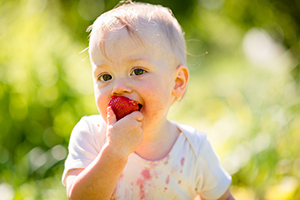Digestion is the process of breaking food down so that nutrients can be absorbed by cells. In your stomach, food is churned and mixed with acid and enzymes. It is then pushed into the first part of the small intestine, where most digestion and absorption takes place.
消化是食物分解,營養物質被細胞吸收的過程。在胃里,食物和胃酸、酶攪拌混合。然后混合物被小腸的第一部分,大部分的消化和吸收發生在這里。
To aid absorption, it is mixed with bile, which is produced by the liver and discharged from the gallbladder through ducts. Digested food molecules pass into blood vessels in the walls of the intestine and are carried up through the portal vein into the liver for further processing and storage. The liver is usually a rich red color, but excess lipids stored in its cells can change it to a whitish color. This is known as fatty liver disease.
為了幫助吸收,混合物和膽汁混合。膽汁由肝臟產生,從膽囊經過導管釋放出來。消化好的食物分子進入腸壁的血管,然后通過門靜脈運送到肝進行進一步的加工、儲存。肝臟通常充滿紅色,但是存儲在肝細胞內的脂肪可以使它的顏色變白。這就是脂肪肝。

It is closely associated with obesity, particularly central obesity involving the omentum—a fatty pad that hangs down from the stomach. Eating too much fat can cause it to push out, producing a large waistline. In some people, eating certain foods can irritate the walls of the small intestine and disrupt regular movement, resulting in altered bowel habits or irritable bowel.
脂肪肝跟肥胖有密切關系,尤其是包含網膜的向心性肥胖——網膜是從胃部垂下來的脂肪墊。吃太多的脂肪可以導致這個脂肪墊突出,增大腰圍線。對一些人來說,吃某些食物可以刺激小腸壁,擾亂小腸的規律蠕動,造成排便習慣異常或者腸應激。
Almost all nutrients have been absorbed by the time digested food leaves the small intestine and enters the colon, where water and salt are extracted leaving solid wastes for elimination.
當食物離開小腸進入結腸時幾乎所有的營養物質已經被吸收了。在結腸中水和鹽被重吸收,固體糞便形成并排出。











